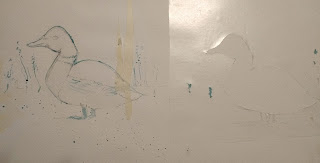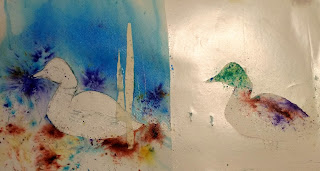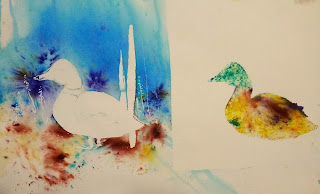In watercolor, preserving the whites of the paper is important. You can always go back and remove whites, but rarely can you get that sparkle back if you lose it. So here are a few ways you can preserve some whites in your paper.
USING MISKIT:
Masking fluid has several names: Pebeo, miskit, friskit, etc. It is a latex liquid that preserves the whites of you paper and is removeable after it is dry.
The good part of masking fluid is that it leaves crisp, hard edges. And the bad part is it leaves crisp, hard edges when you don't want them. All is well... they can be softened.
Materials for using masking fluid are: masking fluid, soapy water (or liquid soap), and an old brush that you won't use for anything else ever. Pour the miskit into a small container and shut the container. Wet the brush, apply some soap,dip it into the miskit, and brush it on. Using a fine brush for miskit is great for strands of hair, fur, and other fine work. The thicker the brush, the thicker you lines will be.
For larger areas miskit can be applied using a number of supplies: silicone shapers, palette knives, drafting pen, bamboo sticks, sponges, etc. The advantages of those others (not including sponges) is that you can let the miskit dry on the applicator and it will just peel off and not damage anything. The palette knife can also be used for fine lines as we did for the tree branches with paint.
Some miskit comes as a pen form. Daniel Smith makes it with tips. (I have a review on that from last fall) I liked it until the tips clogged. After that I was forced to apply it with a brush or other tool.
CONTAC PAPER:

This pic is a little hard to see. It shows contact paper used to cover the duck on the left, so that I have freedom to work with the background. On the right the background is covered to allow freedom to work on the duck.
The one on the left also shows miskit applied to some grasses with a brush and palette knife. The feet are masked off using the silicone tip (shaper), and some dots of it are spattered in the foreground. I wanted to show masking tape also, on the right of the duck.
Reasons to use:
1. You have a large area of white you want to preserve, like a sky (see duck on left)
2. You have very precise edges of something you have painted that you want to protect.(see duck on the right)
There are two basic ways to use contac paper. The first is to trace the shape you want to preserve onto the contac paper and carefully cut it out with scissors. You can cut it to the exact edge if you don't mind a little bleeding of the paint. If you want very precise edges, cut a little larger than your shape. PRESS THE EDGES down with a flat object like a credit card. Then SEAL the edges with a line of masking fluid.
The second way to use contac paper is to cover your entire area with it. Then, with an exacto knife, cut around the shapes you want to preserve. Press the edges down with a credit card. Again, if you don't want any bleeding of the paint, seal the edges with miskit. SEE THE TURTLE PAINTING from my blog on 10/25/16.

On the left, where only the duck was masked off, I was free to experiment with the background. In this case, I wanted to play with Brusho. On the right I was free to use Brusho on the duck without risking it getting into my background.

Contac paper and other masking removed.
PACKING TAPE:
You can use packing tape as you would contac paper. Sounds scary, but for smaller objects, it works well. The advantage of contac paper and packing tape is you can see your drawing/painting through it. This only works on 100% cotton paper. I've tried it on some others, and it can leave a residue on papers that are not cotton rag.
MASKING TAPE:
Masking tape can be use to seal off edges around a building or roof or any area you want to be straight. You might get a little bleeding, but it will be less if you press the edges well.
By ripping down the sides of the tape, you can make more ragged, uneven edges, like a tree trunk. These will be softer edges in a way because they are torn, not cut.
You can also cut shapes either with scissors or exacto knife, just as you would contac paper. You just can't see through it.
BUTCHER PAPER:
Joye Moon uses butcher paper, that heavy white paper with wax on one side. You cut it to the shape you want and IRON it onto your paper. I think it bleeds too much and it peels off when wet. But maybe I am just doing it wrong.
WHITE OR CLEAR WAX CRAYON:
Some people use a white or clear wax, like Susan Schewe's product, to keep the whites, especially the sparkle on water. It is not removeable, however.
NON-REMOVABLE MISKIT
See my blog from last summer/fall on this product.
GUM ARABIC:
See my blog from last summer/fall on this product.It works well as a temporary mask for soft edges, like a moon. You apply it over the area you want to remain white, just using a brush, no soap needed. To remove it, just wet the area with a brush again and blot. I believe Turner and other early water colorists used it for moons, waves, and other areas they wanted preserved.
You can't put layer after layer of paint over this, though, as the constant brushing with water will loosen the gum arabic.

No comments:
Post a Comment